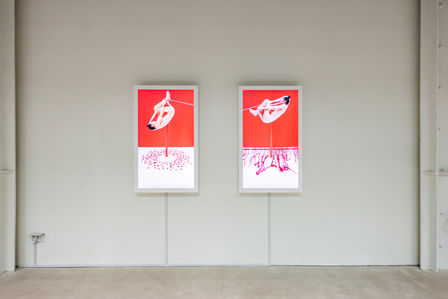THE
SPINNING WHEEL
In a collection of Maiiam Contemporary Art Museum
The Spinning Wheel (2018)—the only two-channel video work in “Performing Textiles”—Vatanajyankur’s facial expression remains composed, if not serene. Such composure throughout sustained exertions amplifies the absurdity of her iterative actions, and serves to bolster her ongoing parody of working life. Indeed, Vatanajyankur’s critique tackles both the unpaid or lowly paid manual labor carried out by women in Thailand (whether domestic or employed), and that of any working person, regardless of income bracket, intent on shoring up wealth. It is the skewed field of capitalism that is Vatanajyankur’s ultimate target.
This is evident not only in the absurd and frequently abject contortions that Vatanajyankur subjects her body to, but also in the hyper-colored backdrops and painted structures she utilizes. Vatanajyankur’s Day-Glo palette mimics the attention-grabbing packaging and advertising of hyper-consumerism. She invokes the strident visual language of capitalism via détournement, and though her absurd, repetitive actions are interpreted as being critical of the system, the artist recognizes that such a critique is positioned from within the capitalist world—the fact that the actions she performs may not derail capitalist mechanisms only adds to a sense of absurdity.
(Pickens R, Performing Textiles, Art Asia Pacific)

2 Channels Video
Edition of 4+3 AP
THE SPINNING WHEEL (RIGHT)
THE SPINNING WHEEL (LEFT)
INSTALLATION
ABOUT
PERFORMING
TEXTILES
The Spinning Wheel is in The National Collection of Thailand (Ministry of Culture) and Maiiam Contemporary Art Museum.
Plunging viewers into a dreamlike world of candy-bright hues and mind-bending physical performance, Kawita Vatanajyankur explores the binaries of Western culture, juxtaposed against the mechanised versus traditional body. By accessing elements of Thai femininity, she invokes a powerful sense of physicality, uncovering a world of often-invisible domestic labour by painfully testing the limits of her own body.
Her dynamic video art is a springboard to explore the value and understanding of the performative body, and the role of gesture within that very performance.
Vatanajyankur’s work is caught in this moment of stasis—time-consuming and physically exhausting. The tonality of happy day-glow colours juxtaposed against dark humour and undercurrents of violence brings violent gravity to her work—drawing attention to mechanisation, and highlighting the historical trajectory of feminist art.
Performing Textiles is a 2018 body of work, capturing the physical manifestation of manual labour processes undertaken by women. Her suite of videos offers a vignette into the physicality and vulnerability of the feminine body.
As a collection, Performing Textiles provokes questions surrounding the place of cultural identity, feminism, labour, consumption and lived experiences—classified through a lens of hyper-coloured realism and the intensity of physical versus material composition.
Textiles undeniably have a place firmly embedded in history, and it is this history of textile production—recognised as women’s labour—that has ingrained itself in our culture. Basketry, loom weaving, knitting, crochet and lacemaking are all feminine material skills that rendered men unnecessary. As such, Vatanajyankur’s practice “focuses on valuing women’s everyday work and labour, while offering a powerful examination of social and cultural ways of viewing women’s work”. Labour exploitation is a major issue within consumeristic society, blocking access to female empowerment and gender equality. Performing Textiles brings this issue into the public sphere.
Textiles are linked symbolically to birth, fertility and reproduction. The practice of working with materials connects women’s bodies to the earth. It is a symbol of life and power. There is a poetic parallel which exists between the creation of new thread and new life. In Greek mythology, The Three Fates were destined to control the ‘mother thread’ of life of every mortal from birth to death, and Athena was considered the goddess of wisdom and weaving. Vatanajyankur’s Dye both explores and subverts this feminine mythology and history. Her body is pushed to the brink of pain and exhaustion—her hair a mop of woollen thread. It is here that the words of Luise Guest resonate. She states: “A woman’s hair is imbued with contradictory meanings—a ‘crowning glory’ that is also abject, a sexual fetish that is also terrifying, a source of power that also signifies vulnerability and subservience”.
The historical relationship between textiles and war are clearly explored in Vatanajyankur’s work. In Iraq and Afghanistan, women used textiles as political commentary to protest violence. During the Soviet occupation of Afghanistan from 1979 to 1989, women wove rugs to cope with the violence surrounding their everyday lives. This provided a source of income for families devastated by warfare—and brought women into a male sphere—giving back power through tools of domesticity.
Vatanajyankur’s experience visiting Toitū Otago Settlers Museum in Dunedin, and the exhibition Women’s War, also influenced her practice. Here, thousands of women sewed and knitted necessities for soldiers during the first world war. As such, textile mediums themselves cannot help but carry a deep tension of conflict. It is a violent history, soaked into the very threads of female life.
Over the last century, women have taken this feminine craft from a private to public space. Textiles have been reinterpreted, and their power reclaimed by women exploited through the associated practice. No longer confined to a domestic space, the value of textiles has been subverted. Its place within performance art can be seen in the pioneering works of Janine Antoni, Yayoi Kusama and Shigeko Kubota. The very essence of Performing Textiles pays homage to this history of performative identity, and continues to grow in the contemporary practice of other female endurance artists.




